Book contents
- Understanding Visuals in the Life Sciences
- Understanding Life
- Understanding Visuals in the Life Sciences
- Copyright page
- Reviews
- Contents
- Foreword
- Preface
- 1 Introduction
- 2 Photographs
- 3 Micrographs
- 4 Illustrations
- 5 Graphs
- 6 Interactive Visuals
- 7 Infographics
- Conclusion
- Summary of Common Misunderstandings
- Figure Credits
- References
- Index
7 - Infographics
Published online by Cambridge University Press: 31 October 2024
- Understanding Visuals in the Life Sciences
- Understanding Life
- Understanding Visuals in the Life Sciences
- Copyright page
- Reviews
- Contents
- Foreword
- Preface
- 1 Introduction
- 2 Photographs
- 3 Micrographs
- 4 Illustrations
- 5 Graphs
- 6 Interactive Visuals
- 7 Infographics
- Conclusion
- Summary of Common Misunderstandings
- Figure Credits
- References
- Index
Summary
As we have seen throughout this book, standalone visuals like photographs and illustrations are promising ways to communicate science to the public – and they carry their fair share of misconceptions and complications. These promises – as well as challenges – are multiplied in infographics.
The word “infographic” comes from the phrase “information graphic.” Originally, the term referred to the production of graphics for print media such as newspapers and magazines. Today it refers to a unique multimodal genre that combines data visualizations (i.e., graphs such as lines, pies, bars, and pictographs), illustrations (such as icons and drawings), photographs, and small amounts of text. When designed for online use, infographics can also have interactive components. For example, putting the mouse cursor somewhere on the infographic may reveal a small pop-up window with additional information. Some infographics are also animated: bars in a bar chart may grow, colors may change, or characters may move. This is often achieved by using animated GIF files that display a sequence of static images in a repeating loop, which creates the illusion of motion.
Keywords
- Type
- Chapter
- Information
- Understanding Visuals in the Life Sciences , pp. 153 - 181Publisher: Cambridge University PressPrint publication year: 2024

